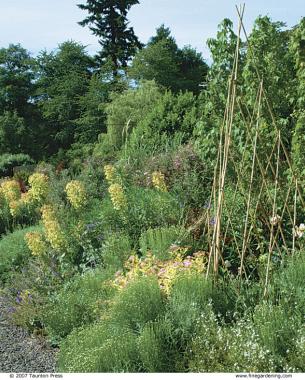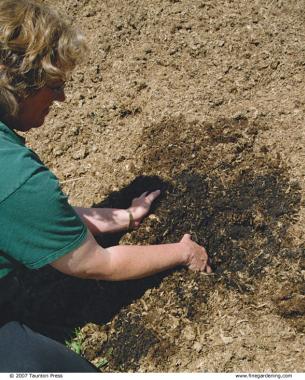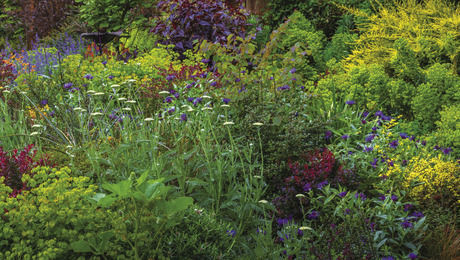Most traditional garden design has been based on principles of control rather than cooperation. As a result, today’s gardens are all too often ecological nightmares. As we enter a new millennium, it’s appropriate to consider entering into a new relationship with the natural world. If there are to be gardens a century from now, they will of necessity be less wasteful and more environmentally benign. I began exploring the gardens of the future by asking questions. How can we create sustainable landscapes and gardens that sit lightly on the earth, recycling as many resources as possible and needing little intervention? What happens when we give preference to plants that thrive with the climate, soil type, and water distribution pattern our bioregions offer naturally? What if we place plants where their natural attributes (such as mature size and shape) are an asset to our design? Can we make gardens that grow old gracefully with us and are more rewarding than demanding?

While researching these intriguing ideas, I learned to make gardens that become easier to care for with each passing year. I learned to eliminate or reduce repetitive chores, from mowing, trimming, and edging to watering and feeding plants. I learned to base my gardens on a matrix of native plants and their allies from similar climate zones— plants that are naturally adapted to the conditions I have to offer them.
On a large scale, sustainable agriculture provides practical lessons in developing and maintaining a closed system that first produces, then uses, all required soil nutrients and organic supplements. Few gardeners can support a herd of dairy cows for their wonderful manure, yet we can all make the best possible use of the green waste our lawns and gardens produce. These days, shredders and advanced composting systems make it possible for anybody anywhere to compost, if only through a worm bin.
Let go of the lawn

Photo/Illustration: Photo taken at Hollandia Nursery, Bethel, CT

Here’s a question I ask all my students: Where do you spend the most chore time in the garden, and which part of the garden is the most enjoyable? Rarely are these places the same. Identifying high maintenance areas helps us to make smart choices about which garden features to alter or eliminate. We may replace a fast-growing hedge with a fence. We may add easy-going shrubs, herbs, bulbs, and ornamental grasses to a needy perennial bed with a short season of good looks. We may replace thirsty fusspot plants with drought tolerant natives. Each choice will free up a bit more time and energy.
For most people, the fastest way to reduce both the weekly workload and high resource use is by getting rid of the lawn. No ground cover or perennial plant you can name needs to be watered, mowed, and fed as often or as much as a lawn. If you have young kids, unmanicured play lawns are great, but plan to edit them out after the kids grow up. How? Start by giving each lawn tree a wide skirt (to the drip line or beyond) of native or regionally adapted plants. Don’t try to plant border beauties; instead, use woodland plants that compete well with and don’t mind the company of tree roots. For year-round good looks, combine spring and summer bulbs with drought-tolerant evergreen ground covers that can be mowed once or twice a year.
For instance, bulbs like spring crocus (Crocus spp. and cvs.) and scilla (Scilla spp. and cvs.), summer-blooming Allium schubertii, and autumn crocus (Crocus spp. and cvs. and Colchicum spp. and cvs.) can be carpeted with delicately textured Vinca minor ‘Miss Jekyll’s White’. For maintenance, just tuck fading bulb foliage under the ground cover and scatter compost on each bed in spring and fall.
Next, create deep crushed-gravel paths that deter weeds and allow excess water to drain away freely. Set pavers or flagstones within them to vary the look in different areas. The main design mistake made by amateur designers is to make their paths too narrow. Six to 8 feet is a good width for a main path, while secondary paths can be 4 to 5 feet wide. This allows two people to walk side by side and permits passage of loaded barrows and carts, strollers, or wheelchairs.
Carve out wide areas along your paths to create sunny and shady seating spaces. Here too, big is better: Soft, simple lines and generosity of scale will make these areas easy to care for, comfortable to use, and visually attractive. Service areas for compost, trash and tool storage, and so forth can also be graveled. Use crushed rock, never pea gravel, which is treacherous underfoot. Graveled areas can be kept weed-free with flame weeders or with vinegar-concentrate products that alter soil pH for up to a year.
Finally, incorporate all narrow strips of grass into beds. The second most common design error is to create beds that are too small. Big, bold beds look best and are easiest to plant without resorting to pruning for size control. Following these steps will leave you with little, if any, lawn. Well-filled beds are far easier to care for than lawn. If you have weeds, you don’t have enough plants.
Again, the models for the gardens I design are the meadows and woodlands where plants succeed each other in effortless waves throughout the year. I fill my beds with a tightly knit matrix of border shrubs, perennials, bulbs, and grasses. In each bed, about a third of the plants are evergreen, and half to a third are native. The others are chosen for drought-tolerance, adaptability, and a long season of good looks.
Make great dirt

I’ve gardened in many places, and although the sites and settings have varied dramatically, the basics remained the same. The secret to having a thriving, healthy garden is to make beautiful dirt. Instead of feeding your plants, feed your soil with compost. The increased biotic life builds soil tilth, making all nutrients more directly available to the plants.
My soil is quite acidic, so I grow plants that enjoy acidic soils. I rarely feed my plants anything but compost, with a spring booster of alfalfa pellets. I do provide mineral supplements once a year or so, scattering them under the annual compost layer. To make annuals and vegetables happy, I double up on compost, which is pH neutral. I experiment with composting techniques and maintain a large brush pile for critter habitat as well.
I brew my own aerobic compost tea weekly and find that spraying these teas on poor soils improves their texture and tilth quickly. Dr. Elaine Ingham, of Oregon State University at Corvallis, says using aerobically brewed compost tea “is like putting down 6 inches of compost without a shovel.” I also find that day-old tea accelerates healthy compost decomposition dramatically. By studying natural models, from woodlands to meadows, I’ve worked toward creating self-mulching gardens filled with plants that die with dignity and that can be allowed to compost on site. I often use “chop-and-drop” grooming to speed this up, cutting big foliage and thick stalks into smaller pieces.
Select plants for their drought-tolerance

Although the maritime Northwest typically has dry summers, I don’t use irrigation systems. Instead, I pick plants that like dry summers. I do my footwork, of course, making great soil and spreading compost. When planting, I use drip irrigation or soaker lines on all trees and shrubs, watering them in for two or three summers after planting. Once established, they are on their own. Newly planted perennials and vines receive one season of supplemental water. Fall-planted bulbs and herbs get none.
To find plants that like your region’s typical water distribution pattern, start with natives. They are already adapted to native soil types and generally grow best with benign neglect. Next, find out which bioregions are most similar to yours. For example, the climate of the Maritime Northwest is considered a modified Mediterranean type. The modifications are obvious: no sun, no heat, lots of rain. The similarities lie in our wet winters and dry summers. Thus, plants from other temperate regions sharing that pattern can reasonably be expected to grow well here.
Mulch, mulch, mulch


To conserve moisture, balance temperature shifts, and suppress weeds, I use deep mulches on all my beds. My preferred mulching materials are compost and well-rotted dairy manure. I use deeper mulches than are generally suggested, because, in my experience, this works beautifully. I add 4 to 6 inches of mulch to all of my beds each year, and my plants love it. During open, snowless winters, I spread mulch from October until April. By May, my borders are too full to see any bare earth, so mulching becomes impractical. The deep mulch eliminates all but minor weeding, watering, and feeding.
Using the principles of sustainable gardening, I’ve learned to make beautiful, abundant, generous gardens that need only a few hours of maintenance each week (or each month during the off-season). It just makes sense.
Fine Gardening Recommended Products

Scotts Cordless Grass-Shear/Shrub-Trimmer Combo
Fine Gardening receives a commission for items purchased through links on this site, including Amazon Associates and other affiliate advertising programs.
- 13.5 x 3 x 5 inches
- Uses a 7.2-Volt 2Ah high-capacity built-in lithium-ion battery; Includes a fast charger

SHOWA Atlas 370B Nitrile Palm Coating Gloves, Black, Medium (Pack of 12 Pairs)
Fine Gardening receives a commission for items purchased through links on this site, including Amazon Associates and other affiliate advertising programs.

Attracting Beneficial Bugs to Your Garden, Revised and Updated Second Edition: A Natural Approach to Pest Control
Fine Gardening receives a commission for items purchased through links on this site, including Amazon Associates and other affiliate advertising programs.


















Comments
Ideas for planting under a large Magnolia(Grandiflora) tree as I take out lawn slowly? Thanks for successful tips..
I'm a huge fan of any of the different varieties of the Japanese painted ferns. They add subtle color tones and interesting texture. Try to resist planting them in a single line all the way around but instead pick a section and go several rows deep and try to imagine how mother nature lets things taper off. Buying a nice sized rock to let there be a reason for the plants to curve around is also an attractive addition. Have fun!
Love the article on low-maintenance gardening. My kind of gardening. I've always said I plant all kinds of stuff but any plant that doesn't like the way I garden can take it's roots and go elsewhere. The funny thing is, lots of plants do just that. They move from sun to shade, or shade to sun, or just turn up on the other side of the lot. We're both happier that way.
A very nice article, I agree with selecting a right plant. And I would like to suggest you, Lavender. Lavender will come back year after year, it has a pleasant aroma and burst of colour and it only needs to be watered once or twice a week.
Log in or create an account to post a comment.
Sign up Log in